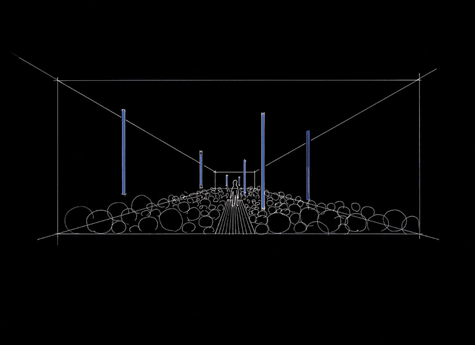Yumi Kori’s “Jukai” transforms Brown’s Bell Gallery
By GREG COOK | September 12, 2007

KORI’S WORK TRANSFORMS THE EXISTING SPACE: into infinite space. |
| “Jukai” by Yumi Kori | Brown University’s David Winton Bell Gallery, 64 College Street, Providence | Through October 11 |
Yumi Kori’s installation “Jukai,” at Brown University’s Bell Gallery, is a magical bubbly midnight wonderland.
You walk down a dark corridor, turn a corner, and find yourself at the foot of a wood-plank dock reaching out into a sea of clear balloons, big and small, plus several that seem to hover in mid-air. Blue lanterns, resembling light sabers, hang from the ceiling, and look a bit like lightning bugs when reflected in the balloons. Here and there the walls reflect the lights and balloons, seemingly to infinity. The sounds — bird songs, crackling bugs, flowing water, wind — are both alluring and a bit disorienting. Birds don’t usually sing at night. Well, at least, not until just before dawn.
The experience feels a bit like walking into Peter Pan or Alice’s Adventures in Wonderland. A wall text explains the title of the installation, “Jukai,” is loosely translated from Japanese as “deep forest or sea of trees.”
“I think of my work as a traveling device,” Kori tells me later. “You come in and you actually travel somewhere else. It transforms the existing space into infinite space.”
“Infinite space” is a theme that comes up repeatedly when the 47-year-old Japanese-born artist and architect talks about her work. It seems to have a number of sources. She splits her time between New York and Tokyo, where she has her architectural practice. Space is tight in that city so she designs her building projects to make small spaces feel larger with a sleight of hand involving shifting lighting and rooms that look different depending on where you enter them.
When she was 26, Kori says, she spent a month mediating 14 hours a day in a small dark cell at a Buddhist monastery in India. “The boundaries disappear,” Kori says. “You feel like a collection of particles.”
Then in 1996 she spent a month at the hospital bedside of her father who was dying of cancer. She says she felt like her father, who passed away at the end, was dissolving, transforming into something else. And she felt like her time there was “suspended time,” as one day blurred into the next.
The following year she began her current body of work. Her installations are distinguished by her attention to light, which distantly echoes Dan Flavin’s fluorescent light installations and James Turrell’s uncanny light boxes, and balloons, which give her installations a playful tone. She filled the cellar of a church in Austria with balloons in 2005 and the corner of a Manhattan gallery last year. In 2004, she mailed balloons and asked recipients to fill their balloon with their breath — and thoughts — and add it to the cluster of balloons at a New York gallery. For her, balloons are fascinating because they hold air, but are surrounded by air. “ It is an object but not so much an object,” Kori says. “I like the fact that for no reason some of them just burst . . . I like that randomness of life. I like that visualization of air that we don’t usually feel. There is ventilation going on, so the air is moving, but you don’t usually notice it.”
Earlier in the gallery, I stood looking for a while. And then I sat at the end of the dock. I listened to the looping sounds by Austrian composer Bernhard Gal. As my eyes adjusted to the darkness, Kori’s special effects became more evident and Kori’s magic began to wear off at bit. But that first lovely disorienting impression — wow.
 Topics
Topics:
Museum And Gallery
, Yumi Kori
, Brown University
, Dan Flavin
, More  , Yumi Kori
, Brown University
, Dan Flavin
, James Turrell
, Peter Pan
, Less
, Yumi Kori
, Brown University
, Dan Flavin
, James Turrell
, Peter Pan
, Less 